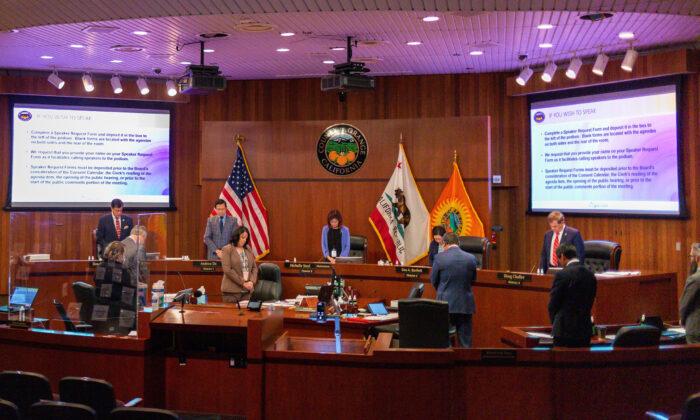Orange County officials said a health equity metric will be considered by the state of California to determine whether the county will elevate to the next, less-restrictive level on the state’s monitoring list for COVID-19.
The metric will be used as one of the criteria for a county to move up to the next color-coded tier in the state’s monitoring system. California released the first set of measurable requirements for the health equity metric on Sept. 30.
Dr. Margaret Bredehoft, deputy director of Orange County’s public health services, said the information provided on Sept. 30 shows that the metric is based on the California Healthy Places Index (HPI) and the county’s census tracts.
The HPI was developed by the Public Health Alliance of Southern California and Virginia Commonwealth University’s Center on Society and Health. The index measures an area’s “non-health” characteristics—such as housing, education, economic stability, and other social factors—according to the organization’s website.
Other data that can also be layered into the index include health outcomes, race/ethnicity, and climate change information.
“In order to advance to the next less restrictive tier, depending on its size, a county will need to meet an equity metric and/or demonstrate targeted investments to eliminate disparities and levels of transmission,” Bredehoft said at an Oct. 1 press conference.
Officials said they were confident some of the actions Orange County has already taken targeting health equity in the last few months will help the county achieve the requirements. One such program was the Latino Health Equity Initiative, launched in June.
However, officials won’t know for sure where the county stands until the state releases the baseline data for each county on Oct. 6. In the meantime, the county will be developing a plan based on the information available.
Orange County’s updated COVID-19 numbers include seven new deaths and 158 diagnosed cases reported on Oct. 1, increasing total fatalities to 1,268 with a cumulative case count of 53,751.
Recent deaths are “overwhelmingly related to the surge in cases a couple of months ago,” Dr. Matthew Zahn, medical director of the county’s communicable disease control division, said at the press conference.
“Our hospital and ICU numbers [since then] have really gone down, which is really important.”
As of Oct. 1, the county has 158 reported hospitalizations, down from more than 700 in mid-July.
Orange County’s weekly COVID-19 data was updated by the state on Sept. 29, showing a testing positivity rate of 3.1 percent and a case rate of 4.4 per 100,00 people. In the previous week, the case rate was only 3.6 per 100,000.
In order to move from the red to the orange tier, the county must have a positivity rate between 2 percent and 4 percent, and a case rate of 1 to 3.9 per 100,000, for two weeks.
Zahn said he continues to see few COVID-19 cases in Orange County schools, “which is definitely a good thing.”
Each recorded case gives a school the opportunity to work with the county to fix any issues and improve their pandemic preparedness plans, he said.
Board of Supervisors Chairwoman Michelle Steel said the county is performing better than all the neighboring counties in cases per 100,000 people.
“Further, Orange County is in the best position of all urban counties in the state,” she said.
Steel also criticized the state for “dragging its feet” on developing a plan to reopen theme parks, even as Disney parks have already reopened in Florida, Japan, France, and China.
“Yesterday was a sad day for Orange County, as Disney had to lay off 28,000 of their employees. Many of these employees are Orange County residents, and I’m worried about them being able to make ends meet,” she said.
“I am disappointed at the lack of progress that California has made in this and other areas. This all could have been avoided, and I hope the state will have answers and give us scientific data for why they have delayed for so long.”
Supervisors Lisa Bartlett and Andrew Do also announced their intent to propose creating an Orange County Office of Suicide Prevention at the next board meeting.
“Orange County has been battling an upward trend in suicides for years,” Do said. “COVID-19 has only exacerbated the root causes of suicides like mental illness and substance abuse.”
Added Bartlett, “Now, more than ever, people who are having a hard time coping and may be contemplating suicide need that additional support to get them through this difficult time.”
The supervisors said the office would be the first of its kind.






Friends Read Free